As We Are
September 7, 2015
It’s next time again.
Great Art can stop the clock. It creates a rupture in time that you can remember all your life. This is one test of great Art, do you remember it? Assuming you do – what is it about the Art or the setting or the experience that stops your internal clock and drives an unforgettable stake into the shifting sands of your memory?
The Venice Biennale of Art provides many opportunities for this. Nothing like Venice to nourish a hunger for beauty and also explore the current state of Contemporary Art. Finding the time to think about Art for a few days is a great luxury and something I don’t do often enough.
Anaïs Nin, in Seduction of the Minotaur said, “We don’t see things as they are. We see things as we are.”
Maybe this is the reason I was not as dazzled as I usually am by this year’s Biennale. The art was probably just as great as it always is but, perhaps I was distracted or just not ready for it. I found about ten of the installations really memorable but, for the rest, I didn’t seem to be in the mood. I instead, became infatuated with some very old Classical Art seen in three remarkable venues. Despite this art being ancient and somewhat familiar, its astonishingly modern presentation (and the sophistication of the ideas that went along with it) seemed breathtakingly new to me.

Okwui Enwezor, Director of the 2015 Venice Biennale pictured here with scholar/philosopher Walter Benjamin
The Director of this year’s Biennale is Okwui Enwezor. He is also the Director of an important contemporary non-collecting museum (The Haus der Kunst) in Munich, and the adjunct curator of the International Center of Photography in New York. He titled this year’s Biennale “All the World’s Futures.” There was a healthy dose of politics in his approach and those politics extended to daily (performance art) readings from the works of Karl Marx. Readings from the original Das Capital had almost a religious connotation to it. This seems fitting since Marx felt the worship of capital (commodity fetishism) was analogous to the “misty realm of religion.” I always like to read the Director’s philosophical statements about their theme for the Biennale and Enwezor’s was fascinating. Turns out, most of what I really enjoyed about it, were the extensively quoted ideas from a man named Walter Benjamin. I will always be grateful to Mr. Enwezor for turning me on to the ideas of Walter Benjamin.
What a find! Benjamin was (no surprise) a Marxist but he writes about Marxism in an experiential way with fabulous insights into Art. This is probably because he had a doctorate in German Romanticism and laced his ideas of Marxist theory with evocative strains of Jewish Mysticism, The Kabbalah, Baudelaire, Kant, and Nietzsche. He wrote movingly about Capital as Religion in 1921. On top of this are brilliant insights into the nature and purpose of Art. Hang in there with me for a moment and you’ll see what I mean.
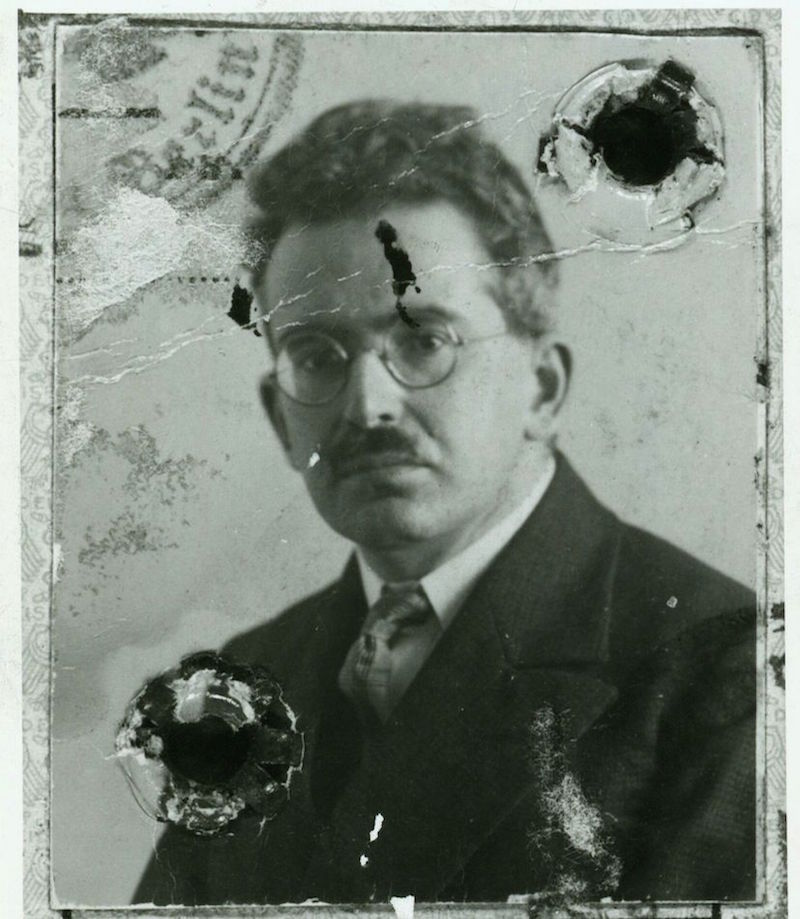
Walter Benjamin’s passport photo. His works are filled with ideas that coincided with the art on this trip with unsettling clarity.
Benjamin totally grabbed me with one of my favorite topics: time. I love Science Fiction books and movies that involve time travel. The nature of time also figures prominently into my love of Eastern religions. For Benjamin, he sees two types of time. Everyday time that he calls “Homogenous Time” and a much more exciting “ruptured” time he calls “Messianic Time.” Think of it this way – what a clock measures second by second is Homogenous Time. Every second is like every other. It is quantifiable and you can sell it because it is what he calls “fundamentally empty.”
The other kind of time is much more special. You have had wonderful moments of Messianic Time in your life. These are the powerfully intense timeless moments you will never forget. If you are lucky, you can dip into these moments and remember them at will. They are not bound by the everyday. They are not boring. Often, these are the moments that make life worth living. Benjamin connects Messianic Time to timeless moments of historical revolution. His Jetztzeit (literally “now time”) is defined by the Oxford reference as: “time at a standstill, poised, filled with energy, and ready to take what Benjamin called the ‘tiger’s leap’ into the future.” Benjamin scholar Andrew Robinson describes Messianic Time as something “the artist or revolutionary blasts free from the ceaseless flow in which it would otherwise be trapped.” He says Benjamin sees “the messianic moment as a stop-chord on a runaway train. History is awakened with a slap born of long-contained frustration, not a kiss.”
I hope I am not trivializing the concept, and I am certainly no expert on Walter Benjamin, but I think he would also believe that ruptures in time can apply to Art.
The Venice Biennale holds the promise of such experiences in every installation. It is a tall order to expect a rupture in time by walking into an Art pavilion and even though “you had to be there” let me give you an example or two.

Over two hundred miles of red yarn and over 50,000 keys in artist Chiharu Shiota’s hands create a sublime time-stopping moment at the 2015 Venice Biennale
You walk into a clean well lighted space with 400 kilometers (250 miles) of red yarn strung through 50 thousand keys. These drip from the ceiling in an impossibly complicated network that stops you dead in your tracks. Buried in this dense red spiders web of yarn and keys are a couple of old rotting boats. How did this possibly happen? It happened with 10 people stringing keys on yarn ten hours a day for two months.
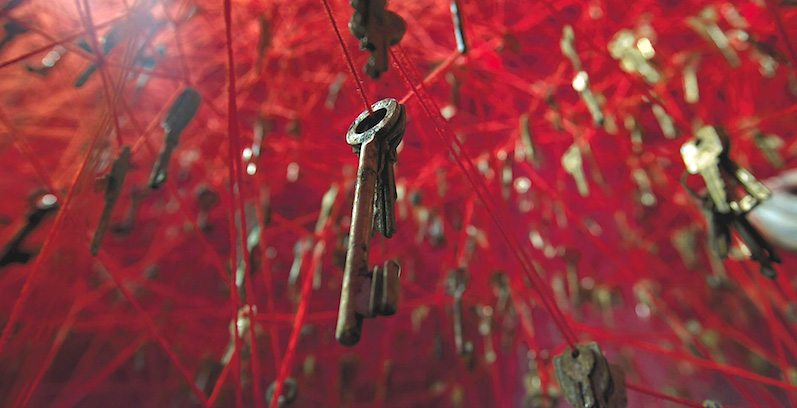
Keys, for the artist, and hopefully for the viewer, hold a sense of mystery and of value. She uses them as a metaphor to unlock memory.
The artist, Chiharu Shiota, who now lives in Berlin says, “ Visitors may feel as if walking around an ocean of memory. The keys are connected to each other by thousands of red strings. Keys are everyday objects that protect valuable things and by coming into contact with people’s warmth on a daily basis, the keys accumulate a web of memories that coexist within us.”
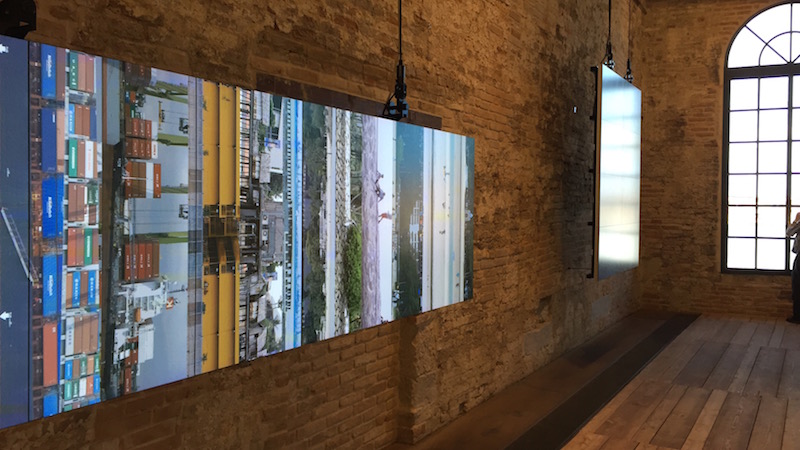
Elegantly hung high def monitors placed on end illuminate the Singapore pavilion’s “Sea State” by artist Charles Lim Yi Yong
Another example, with a totally different feeling is the spare and elegant and very high tech installation called Sea State by Charles Lim Yi Yong for Singapore. Elegant high definition monitors play high quality video of ships. Some of these monitors are on their sides so they create a disorientation of form. A giant 15 foot tall buoy covered in carbuncles looms over the space. Undersea video on a giant high quality monitor completes the illusion. The project looks at land masses disappearing, ecological issues, and the rapid ways in which Singapore is changing. It is also fundamentally about water. The artist says, “In the West, I think they tend to see the sea as sublime, as a space that is an obstacle, a place where you find god, and there are many good reasons for it. One good reason is that when you fall in the water, you normally have only 15 minutes to live before you get hypothermia, so Europeans build up all these narratives of the sea being dangerous.
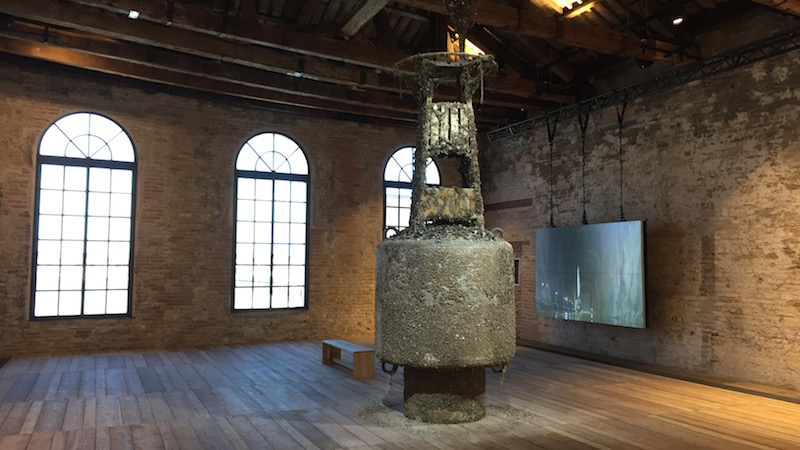
Barnacle encrusted buoy from Sea State towers over the installation and creates a disorienting juxtaposition of scale
But my relationship with water is very different. In Singapore and in a lot of equatorial regions, the temperature of the sea is the same as your internal body temperature. It’s similar to your blood in a sense. When there is a storm that comes, sailors and fishermen fill their boat with water and immerse their bodies in water, because the sea water is warmer than the air temperature during a storm. So this work also opens up new ways of looking at water.”
As arresting, elegant and memorable as these and many other installations by contemporary artists were, it was art from very long ago that I will remember the most from this trip. I should clarify these installations of Classical art were not a part of the Enwezor’s Biennale. They connected so deeply with Benjamin’s ideas only because this is what was on my mind.
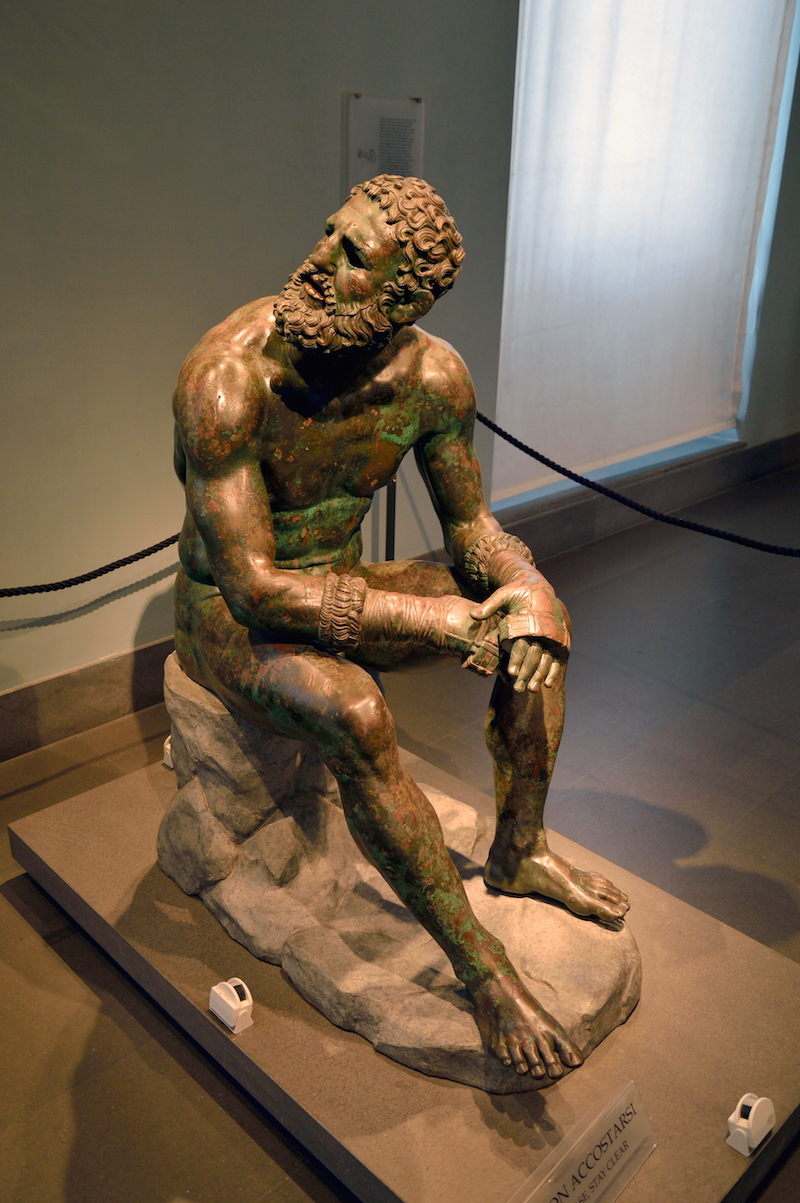
The astounding “Boxer of Quirinal.” An impossibly rare Hellenistic bronze from 330 B.C. His palpable presence filled the gallery at the Palazzo Strozzi’s exhibition and stole the show.
To prove that great Art creates a rupture in time look no further than this haunting figure from 320 B.C. I met him inside the Palazzo Strozzi in Florence where he became the impossible to forget hero of a magnificent show they did on Hellenistic Bronzes. Many of these bronzes were recent finds from shipwrecks or excavations that arrested the ravages of time.
The Boxer at Rest, now in the Museo Nationale Romano, was not buried at sea but instead literally buried and brought back from the dead in 1885 during excavations in Rome near the baths of Constantine.
Seán Hemingway, Curator, Department of Greek and Roman Art at the Metropolitan Museum in NY (where the boxer visited in 2013) writes, “His broken nose and cauliflower ears are common conditions of boxers, probably the result of previous fights, but the way he is breathing through his mouth and the bloody cuts to his ears and face make clear the damage inflicted by his most recent opponent. The muscles of his arms and legs are tense as though, despite the exhaustion of competition, he is ready to spring up and face the next combatant.”
I could not help but stand next to him and gaze into his eyes. His expression so haunting. I felt him thinking thoughts from so many thousands of years ago. In the disturbing silence of stopped time a voice in my head said, “You talkin’ to me? What’re you looking at?”
Leave it to Walter Benjamin to put his finger directly on another very contemporary (and classical) idea. What is it about a work of Art is unique and cannot be duplicated? One of Benjamin’s most famous essays is The Work of Art in the Age of Mechanical Reproduction. He writes eloquently about film, photography and Art and ponders what the difference is between a unique work of Art (sometimes in a particular place) and a representation or replica of a work of art created by increasingly sophisticated technology?
I find this fascinating. Most of our interactions with art are now from photographs and reproductions. The original piece, Benjamin claims, has what he calls an “aura” that cannot be duplicated. I think digital reproduction and high definition would certainly have blown Benjamin’s mind but I bet he would say the same thing today. Seeing a work of art, even on film, is not the same as seeing it in the flesh. The difference is a fascinating and subtle thing to explore.
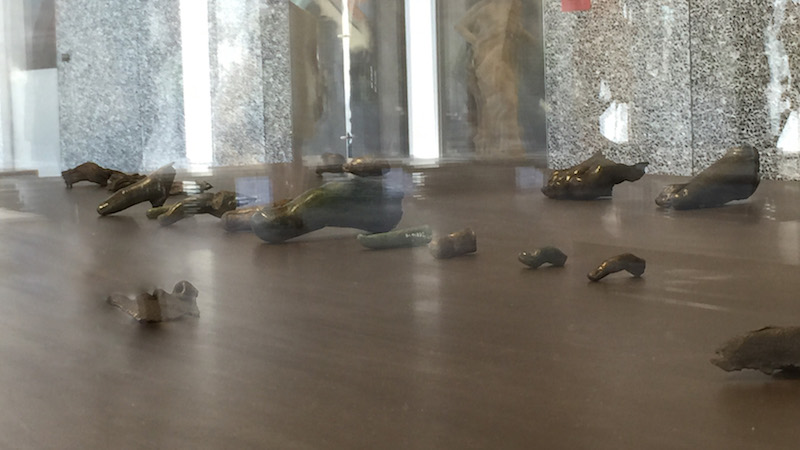
A glass case displays small, rare fragments of bronzes from Olympia in Greece to open the Serial Classic show at the Prada Foundation in Milan. These are the originals, everything else in the show is a copy.
And so they did at the first exhibition of the PRADA Foundation in Milan. The exhibition Serial Classic begins with tiny fragments of ancient bronzes from ancient Olympia – fingers, eyes, feet, hands, genitals, eyelashes and ears. One of the curators, Salvatore Settis, explains, “Scholars estimate between 1,000 and 3,000 bronze statues were on display in Olympia alone. … [but] metal in the Middle Ages was worth more than the works of art. As a result, the artistic heritage of antiquity has been almost entirely lost, and no more than 2 percent remains. Today, scarcely one hundred more or less complete Greek bronzes survive, almost all of which were rediscovered in the past 120 years, often pulled up from the sea millennia after having sunk along with the ships that carried them.
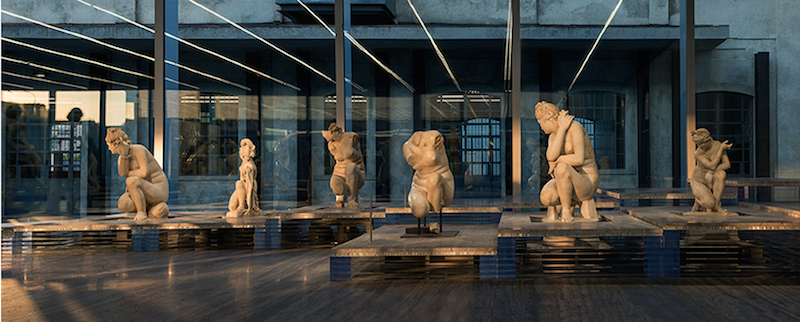
Installation view of “Serial Classic” at the PRADA Foundation in Milan. Their new building complex was designed by Renzo Piano
“But, the Romans developed a passion for Greek art and had many copies made of Greek statues which, thanks to their sheer numbers survived better than the original prototypes. The copies give us an idea of what the lost originals looked like, because they were the product of a mechanical, serial process of reproduction. It is in these copies that we can rediscover traces of the originals by great master sculptors (Phidias, Myron, Polyclitus, Praxiteles) mentioned in Greek and Roman sources.”
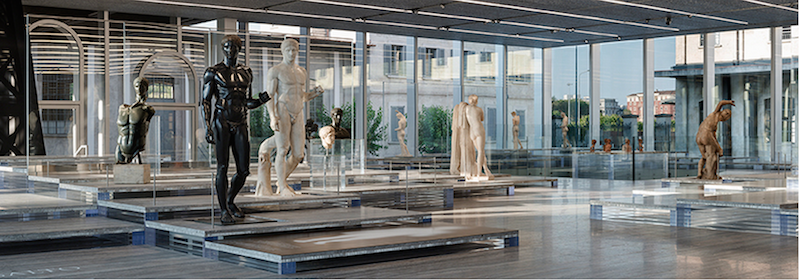
Leave it to the PRADA Foundation to create perhaps the most elegant display of Classical sculpture ever to be put on exhibition.
How perfect is this concept for PRADA that makes its money from the “serial” reproduction of designer originals? Walter Benjamin would have adored this show. Think of it. “reproductions” from the first century B.C.! Leave it to PRADA not to cheap out on more recent copies. The copies they displayed (on the most exquisite lucite platforms ever devised by man) were often “the real deal” from the Capitoline Museum in Rome, Herculanium, The Louvre and other great museums and institutions too numerous to mention.

Installation view of exhibition Portable Classic. Note the painting showing a family proudly displaying the Classical sculpture they have collected. Photo by: Atilio Mercanzano, courtesy Fondazione PRADA
As if this were not enough, the PRADA Foundation in Venice did a companion show called Portable Classic. This show was all about the collecting of copies of great Classical artistic works from antiquity. Again, the ideas of Walter Benjamin filled me with coincidental wonder. Consider his comments about collecting as quoted and distilled by Andrew Robinson writing for Ceasefire. (It is primarily due to Robinson’s distillations and explanations of Benjamin’s ideas that I found such meaning in Benjamin’s ideas.) Robinson explains, “In the article ‘Unpacking my Library’, Benjamin discusses the relationship of a collector to objects which are collected. Crucially, collecting is about liberating objects from their status as commodities or as instrumental objects for use. Instead, the collector places objects in a kind of magical arrangement. Collecting is thus a way of renewing the world. An object acquired for the collection is ‘reborn’ into it. The collector feels responsible towards the objects, rather than the reverse. Further, the collector comes to life in the objects. A collection exists between order (the arrangement of objects) and disorder (the passion for collecting). It is a passionate phenomenon. Collecting creates a mood of anticipation, and always carry memories from the moments of acquisition.”

The centerpiece of the Portable Classic exhibition at the PRADA Foundation inside the Palazzo Corner in Venice. The timeless form of the colossal Farnese Hercules reproduced in throughout time. One size does not fit all.
The centerpiece of the Portable Classic exhibition was a line of reproductions of the famous colossal Farnese Hercules (now in the famous Archeological Museum in Naples) dating from the third century A.D., signed by Glykon from an original by Lysippos made in the fourth century B.C.
I started at the small end and felt as if I was paging through history in giant clumps of time. I knew they were not in chronological order but it was fascinating to see how this image was interpreted and re-interpreted over the ages. The statues seemed like bookmarks in time. Imagine my surprise when I finally got to what I thought was the actual Farnese Hercules and discovered it too was a copy – a giant sized epoxy replica created only last year!
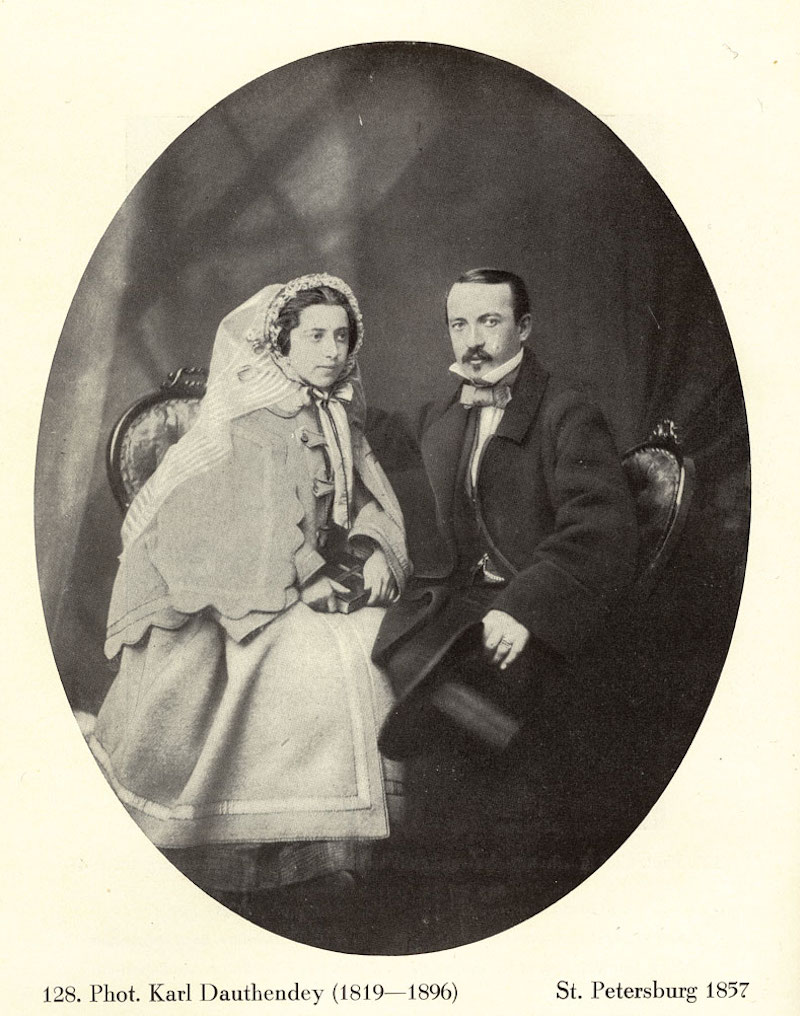
This photograph from the early days of still photography haunted Walter Benjamin who saw impending tragedy in the face of the photographer’s bride.
Finally, Benjamin also has much to say about another love of mine (and probably yours) photography. Not surprising that he would love the way photographs stop time. In his essay, A Short History of Photography, he writes about an early “daguerreotype” self portrait/wedding photo shot by the French photographer, Karl Dauthendey. Benjamin knows that Dauthendey found his wife’s bloody body after she had slit her wrists and therefore filled with the Jetzzeit of the moment, frozen by the new invention of the camera, he muses, “One comes upon the the picture of Dauthendey… from around the time of his wedding, seen with the wife whom one day shortly after the birth of their sixth child he found in the bedroom of his Moscow house with arteries slashed. She is seen beside him here, he holds her; her glance, however, goes past him, directed into an unhealthy distance. If one concentrated long enough on this picture one would recognize how sharply the opposites touch here. This most exact technique [photography] can give the presentation a magical value that a painted picture can never again possess for us. All the artistic preparations of the photographer and all the design in the positioning of his model to the contrary, the viewer feels an irresistible compulsion to seek the tiny spark of accident, the here and now. In such a picture, that spark has, as it were, burned through the person in the image with reality, finding the indiscernible place in the condition of that long past minute where the future is nesting.”
But, ultimately, as we all do, Benjamin sees what he wants to see. It turns out the woman in the photograph is Dauthendey’s second wife. It was his first wife that committed suicide. The death wish he sees is just a projection of Benjamin’s mind, fueled by incomplete facts. Benjamin was moved by the story and the photograph somehow touched a nerve within his own experience. “We don’t see things as they are, we see things as we are.” Tragically, years later in Spain, Benjamin would also commit suicide so as not to be returned to Nazi persecution in Germany.
As I think about his ideas and I remember the great art I saw on this trip, I am grateful to have such vivid memories, ungoverned by time, that I will never forget.
Until next time, I remain your,
Tommaso






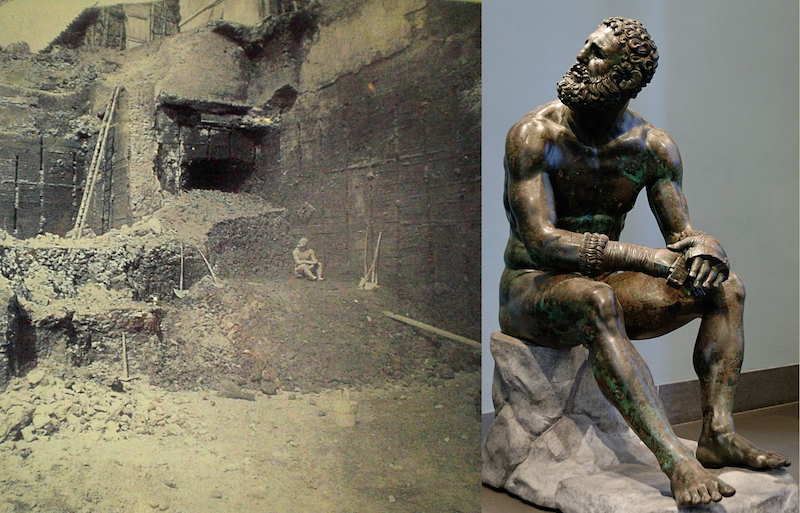

3 Comments
Thank you so much Tom for another great blog. I haven’t been in Venice for many years, however, thanks to your pictures and comments, seeing in in the screen is a window to your world. I was fortunate to see the Ancient sculptures at the Getty, and I was particularly impressed by the beauty and power of the “Boxer of Quirinal”. The pictures of the “Serial Classic” and “Portable Classic” shows were amiazing…Thank you so much for sharing!
Dear Tommaso,
Again, you stagger me with your insights, and especially the issue of time being stopped, through the insight of Walter Benjamin, and his biographer Andrew Robinson. In our memories, stopping time, at very significant moments– and you say “not with a kiss”! Benjamin would have seen Der Rosenkavalier, possibly under the baton of Mahler, in Vienna, and understood the issue of stopping time WITH a kiss; which was what happens in Sophie, the young woman being presented with the symbolic silver rose, by a dashing cavalier, all in silver. The music by Richard Strauss has this shimmering violin time-stopping light aria, and sweeps us off our feet in that “I fell in love the first moment I saw you” way. Later in the opera, there is a marvelous aria by the older woman, Marie Therese, who is so aware of passing time, fading beauty, the loss of the lovely romance with the young count, as he falls in love with Sophie. “Time, it is a mysterious thing…” she sings. It has a bit of minor melody and a scurrying against the meter, and the anxiety of a woman who is remembering her youth, the golden optimism of youth; and as she looks in the mirror, and turns away, you feel all the heaviness and sadness, of loss, of a woman moving into middle age and beyond. She says she thinks she will go to the chapel and pray. She will go in her carriage for a ride, to amuse herself. But it is not what she would really WANT before. Even the waning of desire is somehow contained in her song. This is the most exquisite opera about time and love, that I know. It also has been a timepiece in my life. The young man I loved at 17 was gay, so our relationship was not to become a love-affair, but we were friends for almost 50 years. He died on 10/10 of pancreatic cancer. He used to sing baritone, and he sang in the SF chorus. Kevin gave me a silver rose, and the recording of Der Rosenkavalier, for my 25th birthday. We went together over the years, to different productions, and each time were held in that timeless memory of Sophie and the silver rose. The final trio is a heart wrenching thing, where the young count stands between the two women he loves, and has to choose, or understand what he is choosing and why. It is the most amazing and powerful trio of absolutely stunning melody, rising and rising to heartbreak. Kevin’s friend will play the last trio at the memorial for him which is this month. My mind is full of the moments we shared, the German high romanticism— probably Kevin, who lived 15 years in Heidelberg, knew all the writings of Walter Benjamin first-hand. His name is familiar to me, but I didn’t know why. In the years in which he was writing Rilke was also writing poetry, and in the 30s Martin Buber, an orthodox Jewish philosopher, presented “I and Thou” which is also very important in this issue of what is real to each of us as a person, and where do we intersect with the Divine. Henri Bergson also was writing about time. It is amazing to me, this coincidence in your presenting these thoughts, as you witnessed this beautiful presentation of the classical sculptures. That boxer is breathtaking! And the kneeling woman in marble. I love the photo of the painting of the family who were the collectors, and the statue off to the side slightly! It made me remember the book “The Hare with Amber Eyes” which perfectly dove-tails with what you say about collecting– it is about a family collection of Netsuke, the tiny Japanese carvings which came to an uncle around the time of the impressionists painting in Paris, when Japonisme was so “au courant” Then the collection was sent to Vienna for a wedding present, and it went through the horrors of the extermination of the Jews in Vienna, and was saved in the apron pocket of the humble housekeeper. After the war, the collection is serendipitously and joyfully brought back to Japan! I highly recommend this book— it is an amazing touchstone of the issues of collecting, of loving the collection, of understanding how a collection is part of one’s memories and life, how it occupies our emotional landscape and private space and time. And also, how it carries so much of the anthropology of the time in which it was made! The last thing I want to say is that I have been listening to Lorraine Hunt Lieberson, whose voice still astounds and blesses me. Since Kevin’s death, listening to her has been the way to deal with the heartache of loss. It is through you, and your friend Charles, that I found her. But yesterday I got a recording of French songs by Anne Sophie von Otter. She is a miracle of a voice. Time-stopping indeed! Her singing of songs by Faure and Poulenc are exquisite. They bring me back to that year I was 20, in Vienna, listening in my opera workshop class to singers who came to sing to us, in the intimacy of a classroom with a piano, played by our professor Herr Stofsky, astonishing music which was like smoke, it was so ephemeral.
When you speak of photography, and show us that photo of Benjamin and his passport, and I think of the heartbreak that the extermination of Jews was proceeding inexorably, devastatingly, across Europe, and included some of the best minds and best creative voices of that time, I just want to sob. When I look at the eyes of that wife, looking away into the middle distance, with a face of both softness and determination, I think of Auschwitz and Dachau. I am glad you gave us that boxer, because his injuries and his physical intensity make him so vivid, all these centuries later. He is not erasable! THANK YOU again, for a reflection I will come back to, and which brims with other references for me– like Anais Nin, who was one of the people I really loved to read when I was in my early 20s. One hopes that we become even more ourselves, as we contemplate these memories, these loves, the passions of our lives. THANK YOU!
Such wonder — now I must read Walter Benjamin. Wish I could have experienced the art that you did there. I think probably the most important mind-opening experience with art that I have ever had was when I saw the David in Florence, in the flesh, so to speak. I had seen countless pictures and several replicas. But standing with that statue — time stopped, and I was sure I saw it actually breathing. That was when I realized the magic of the real thing and not the copy, and that there must be some sort of life in the creation, life that is also of and from the artist. The artist is still living inside that stone.